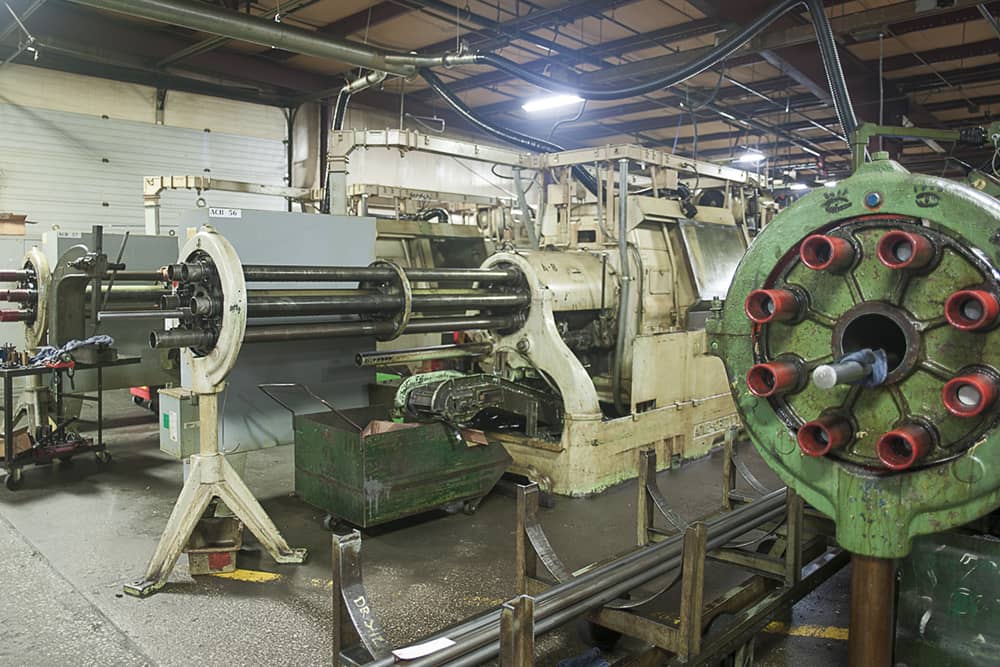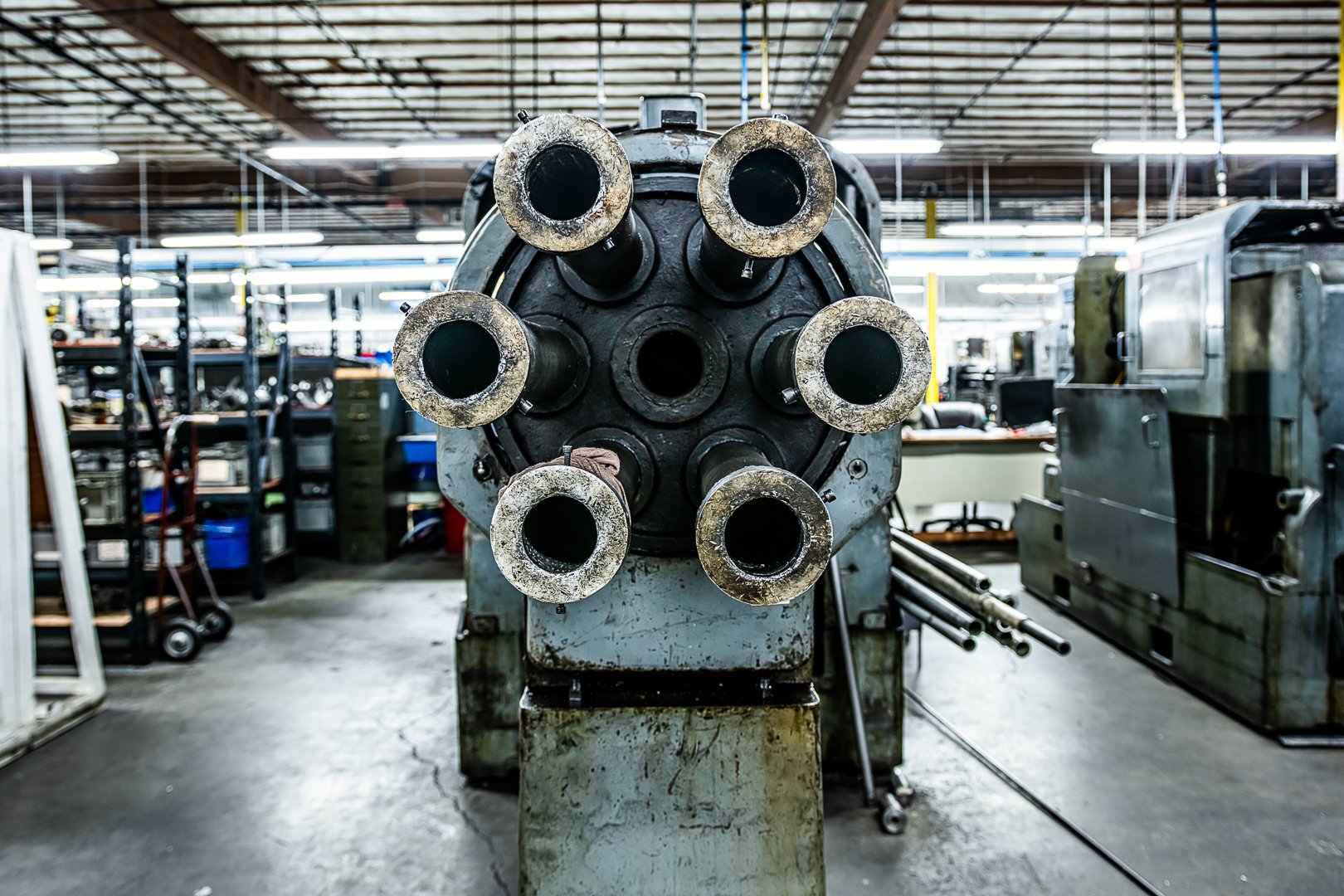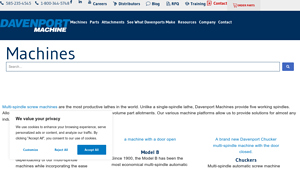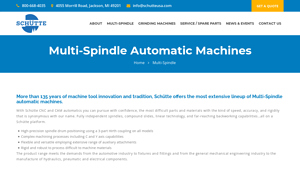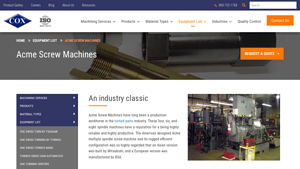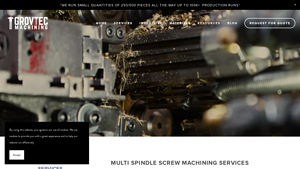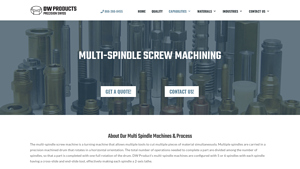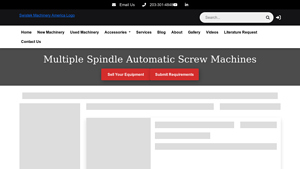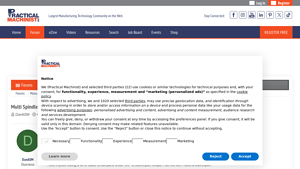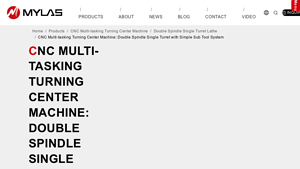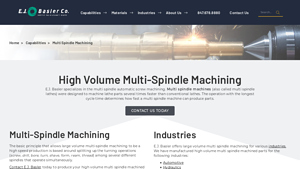Multi Spindle Screw Machine Guide: Type, Cost, Top List…
Introduction: Navigating the Global Market for multi spindle screw machine
In the fast-paced world of manufacturing, sourcing a multi spindle screw machine can present significant challenges for international B2B buyers, particularly in regions like Africa, South America, the Middle East, and Europe. With the demand for high-volume, precision parts skyrocketing across industries such as automotive, aerospace, and medical, the ability to select the right machinery is crucial for maintaining competitive advantage. This comprehensive guide aims to demystify the complexities associated with multi spindle screw machines, providing valuable insights into their various types, applications, and key features that drive productivity and efficiency.
Throughout this guide, buyers will gain a deep understanding of the different machine models available—from classic options like the Model B to advanced hybrid machines that integrate CNC technology. We will explore essential considerations for supplier vetting, helping you identify reputable manufacturers that meet your specific requirements. Additionally, we will outline cost factors and potential return on investment, empowering you to make informed purchasing decisions that align with your business goals.
By equipping international buyers with actionable insights and a detailed overview of the multi spindle screw machine landscape, this guide serves as a critical resource for optimizing your procurement strategy. Whether you’re seeking to enhance production capabilities or streamline operational efficiency, you’ll find the information necessary to navigate the global market with confidence.
Understanding multi spindle screw machine Types and Variations
| Type Name | Key Distinguishing Features | Primary B2B Applications | Brief Pros & Cons for Buyers |
|---|---|---|---|
| Davenport Model B | Five spindles, fast index speeds, compact design | Automotive, aerospace, medical components | Pros: High speed, cost-effective, proven reliability. Cons: Limited to specific part sizes. |
| Hybrid Machine | Combines mechanical dependability with CNC accuracy | High-volume production across various sectors | Pros: Versatile, precise, suitable for tough materials. Cons: Higher initial investment. |
| Schütte SCX Series | Fully independent spindles, modular design | Complex parts for automotive and hydraulics | Pros: Flexibility in operations, high precision. Cons: More complex setup and maintenance. |
| Chucker | Designed for secondary operations on preformed blanks | General mechanical engineering, fixtures | Pros: Versatile, can handle secondary operations. Cons: May require additional equipment for primary operations. |
| G Series | Small part production, combines cam and CNC technology | Electronics, small turned parts | Pros: High reliability, ideal for small components. Cons: Limited to smaller diameter parts. |
What Are the Key Characteristics of the Davenport Model B Multi-Spindle Screw Machine?
The Davenport Model B is renowned for its five-spindle configuration and rapid indexing capabilities, making it one of the most efficient machines for high-volume production. It has been a staple in the industry for over a century, demonstrating proven reliability and cost-effectiveness. This machine is particularly suited for industries requiring precision parts, such as automotive and aerospace. Buyers should consider the specific part sizes and volumes they need to produce, as the Model B is optimized for certain dimensions.
How Does the Hybrid Machine Enhance Production Efficiency?
The Hybrid Machine integrates the mechanical reliability of traditional multi-spindle machines with the advanced features of CNC technology. This combination allows for enhanced precision and flexibility in handling a variety of materials, including difficult alloys. It is particularly beneficial for high-volume production where accuracy is crucial. While it offers superior capabilities, prospective buyers should evaluate their budget, as the initial investment may be higher compared to simpler models.
In What Situations Should Businesses Choose the Schütte SCX Series?
The Schütte SCX Series stands out due to its modular design and fully independent spindles, which allow for complex machining processes. This machine excels in applications requiring high precision and flexibility, making it ideal for industries such as automotive and hydraulics. However, the complexity of setup and maintenance may pose challenges for some organizations. Buyers should assess their technical capabilities and the specific demands of their production processes before opting for this advanced machine.
What Advantages Does the Chucker Multi-Spindle Machine Offer?
Chucker machines are specifically designed to perform secondary operations on preformed blanks, making them versatile tools in general mechanical engineering and fixture manufacturing. They can be adapted for various applications, allowing businesses to streamline their production processes. However, buyers should note that while Chuckers excel at secondary operations, they may require additional equipment for primary machining tasks, which could increase overall production costs.
Why Should Companies Consider the G Series for Small Part Production?
The G Series machines are tailored for the production of small turned parts, combining the speed of cam-driven operations with the flexibility of CNC technology. This makes them ideal for sectors like electronics where precision and reliability are paramount. While they excel in handling small diameters, businesses should be aware of the limitations regarding part size and consider whether their production needs align with the capabilities of the G Series.
Key Industrial Applications of multi spindle screw machine
| Industry/Sector | Specific Application of multi spindle screw machine | Value/Benefit for the Business | Key Sourcing Considerations for this Application |
|---|---|---|---|
| Automotive | Production of precision engine components | High-volume output with reduced cycle times | Supplier reliability, machine versatility, and maintenance support. |
| Aerospace | Manufacturing of intricate aircraft parts | Ability to handle complex geometries and materials | Certifications for aerospace standards, precision capabilities, and material handling. |
| Medical Devices | Creation of surgical instruments and implants | Consistency in quality and precision for safety | Compliance with medical regulations, flexibility for custom designs, and quick turnaround. |
| Electronics | Fabrication of electronic connectors and housings | Efficiency in mass production of small components | Compatibility with various materials, technology integration, and after-sales support. |
| Hydraulics & Pneumatics | Production of valves and fittings | Streamlined processes for high-volume production | Custom tooling options, adaptability for different part sizes, and service availability. |
How are Multi-Spindle Screw Machines Used in the Automotive Sector?
In the automotive industry, multi-spindle screw machines are utilized for producing precision engine components such as shafts, valves, and gears. These machines allow manufacturers to achieve high-volume outputs with significantly reduced cycle times, which is crucial for meeting the demands of a competitive market. Buyers in this sector should prioritize suppliers who demonstrate reliability and can offer versatile machinery capable of adapting to various part specifications, ensuring consistent production quality.
What Role Do Multi-Spindle Screw Machines Play in Aerospace Manufacturing?
Aerospace manufacturers rely on multi-spindle screw machines to create intricate aircraft parts, including brackets and housings, that require exceptional precision and strength. The ability to handle complex geometries and difficult-to-machine materials makes these machines invaluable in this sector. International buyers should consider sourcing from manufacturers with aerospace certifications and proven precision capabilities to ensure compliance with strict industry standards.
How are Medical Devices Benefited by Multi-Spindle Screw Machines?
In the medical devices sector, multi-spindle screw machines are instrumental in the production of surgical instruments and implants. These machines provide a consistent quality and precision necessary for ensuring the safety and efficacy of medical products. Buyers should look for suppliers who adhere to medical regulations and can offer flexibility for custom designs, as well as quick turnaround times to meet urgent market needs.
Why are Multi-Spindle Screw Machines Essential for Electronics Manufacturing?
The electronics industry uses multi-spindle screw machines for the fabrication of electronic connectors and housings. These machines enhance efficiency in the mass production of small components, which is essential in an industry characterized by rapid technological advancements. Buyers should seek machines that are compatible with a variety of materials and offer seamless technology integration, as well as robust after-sales support to minimize downtime.
How Do Multi-Spindle Screw Machines Optimize Production in Hydraulics and Pneumatics?
In the hydraulics and pneumatics sector, multi-spindle screw machines are employed to manufacture valves and fittings that require precision and reliability. These machines streamline production processes, enabling manufacturers to meet high-volume demands effectively. When sourcing, buyers should evaluate the availability of custom tooling options and the machine’s adaptability for different part sizes, along with the supplier’s service capabilities to ensure ongoing operational efficiency.
3 Common User Pain Points for ‘multi spindle screw machine’ & Their Solutions
Scenario 1: Difficulty in Achieving Precision with Complex Parts
The Problem:
B2B buyers often face challenges when producing intricate components that require high precision. Multi-spindle screw machines are designed for mass production, but when tasked with creating complex geometries or tight tolerances, users may find that their machines struggle to maintain accuracy. This can lead to higher scrap rates, increased costs, and ultimately, customer dissatisfaction if the parts do not meet quality standards. Moreover, operators may not have sufficient training or experience to set up the machines for these complex tasks, compounding the issue.
The Solution:
To address this challenge, it is crucial for buyers to invest in multi-spindle screw machines that come equipped with advanced CNC capabilities. Machines like the Davenport Hybrid model offer the necessary flexibility and precision required for intricate designs. When sourcing equipment, buyers should prioritize vendors that provide comprehensive training programs for operators to ensure they understand how to optimize the machine settings for complex parts. Additionally, utilizing simulation software during the setup phase can help predict and rectify potential machining issues before production begins, significantly reducing errors and improving overall efficiency.
Scenario 2: High Setup Times Leading to Inefficiencies
The Problem:
Another common pain point for B2B buyers is the lengthy setup times associated with multi-spindle screw machines, especially when switching between different production runs. This downtime can severely affect productivity and profitability, particularly for manufacturers who need to respond quickly to market demands. Buyers may find that frequent retooling leads to operational bottlenecks, slowing down their ability to fulfill orders on time.
The Solution:
To combat long setup times, businesses should consider investing in multi-spindle machines that feature quick-change tooling systems. These systems allow for rapid adjustments between different parts, minimizing downtime. Additionally, implementing lean manufacturing principles can streamline the setup process. Buyers should develop standardized procedures for tool changes and invest in training for their teams to ensure everyone is adept at executing these changes efficiently. Keeping an inventory of pre-set tools and fixtures can also facilitate quicker transitions between jobs, thereby enhancing overall throughput.
Scenario 3: Challenges with Material Compatibility and Processing
The Problem:
Many buyers encounter difficulties when working with diverse materials, particularly harder alloys or specialty metals. Multi-spindle screw machines that are not designed to handle such materials may experience increased wear and tear, resulting in frequent maintenance and downtime. This not only affects production schedules but also raises operational costs due to the need for additional repairs or replacements.
The Solution:
When selecting a multi-spindle screw machine, it is essential for buyers to consider the specific materials they intend to process. Opting for machines like the Schütte SCX Series, which are designed with robust spindles and high-precision tooling, can provide the necessary rigidity and durability to handle difficult materials. Furthermore, buyers should work closely with machine manufacturers to understand the capabilities and limitations of their equipment concerning different materials. This collaboration can also include seeking recommendations for specialized tooling that enhances processing efficiency. Regular maintenance schedules and operator training on material handling will ensure the machines remain in optimal condition, reducing the risk of operational disruptions.
Strategic Material Selection Guide for multi spindle screw machine
What Are the Key Materials Used in Multi-Spindle Screw Machines?
When selecting materials for multi-spindle screw machines, it’s essential to consider the specific properties, advantages, and limitations of each material. This analysis focuses on four common materials: Steel, Aluminum, Brass, and Stainless Steel, providing actionable insights for international B2B buyers.
How Does Steel Perform in Multi-Spindle Screw Machine Applications?
Key Properties: Steel is renowned for its high tensile strength and durability, making it suitable for high-pressure and high-temperature applications. It generally exhibits excellent wear resistance, which is critical for maintaining precision in machining operations.
Pros & Cons: The primary advantage of steel is its durability and ability to withstand significant mechanical stress. However, it can be more expensive than other materials, especially when considering high-grade alloys. Manufacturing complexity can also increase, particularly for intricate designs.
Impact on Application: Steel is compatible with a wide range of media, including oil and gas, making it ideal for industries like automotive and aerospace. Its robustness ensures that components can endure harsh operational conditions.
Considerations for International Buyers: Buyers from regions such as Africa and South America should consider local steel grades and compliance with international standards like ASTM. In Europe, adherence to DIN standards is crucial, while in the Middle East, local certifications may apply.
What Advantages Does Aluminum Offer for Multi-Spindle Screw Machines?
Key Properties: Aluminum is lightweight and has excellent corrosion resistance, which is beneficial in environments that may expose components to moisture or chemicals. It also has good thermal conductivity, making it suitable for applications requiring heat dissipation.
Pros & Cons: The lightweight nature of aluminum allows for faster machining speeds and reduced energy consumption. However, it is less durable than steel and may not be suitable for high-stress applications. Additionally, the cost can vary significantly based on the alloy used.
Impact on Application: Aluminum is commonly used in industries such as aerospace and electronics, where weight savings and corrosion resistance are critical. Its compatibility with various media, including water and air, makes it versatile.
Considerations for International Buyers: Buyers should be aware of the specific aluminum grades and their compliance with standards like JIS in Japan or EN in Europe. In regions like Germany, the use of recycled aluminum is often encouraged, impacting sourcing strategies.
Why is Brass a Popular Choice in Multi-Spindle Screw Machines?
Key Properties: Brass is known for its excellent machinability and corrosion resistance, particularly in marine environments. It also has good thermal and electrical conductivity, which makes it suitable for electrical components.
Pros & Cons: The main advantage of brass is its ease of machining, allowing for complex shapes and fine tolerances. However, it is generally more expensive than steel and aluminum, and its mechanical strength is lower, limiting its use in high-stress applications.
Impact on Application: Brass is widely used in plumbing, electrical fittings, and decorative applications. Its compatibility with water and various chemicals makes it ideal for these uses.
Considerations for International Buyers: Compliance with standards such as ASTM B16 for brass fittings is essential. Buyers in Europe may also need to consider environmental regulations regarding lead content in brass alloys.
What Role Does Stainless Steel Play in Multi-Spindle Screw Machine Manufacturing?
Key Properties: Stainless steel is highly resistant to corrosion and oxidation, making it suitable for a wide range of environments. It also maintains strength at high temperatures, which is essential for many industrial applications.
Pros & Cons: The key advantage of stainless steel is its durability and resistance to corrosion, making it ideal for food processing and medical applications. However, it can be more challenging to machine compared to other materials, leading to increased manufacturing costs.
Impact on Application: Stainless steel is commonly used in the food and beverage industry, medical devices, and automotive components due to its hygienic properties and strength. Its compatibility with various media, including acids and bases, enhances its versatility.
Considerations for International Buyers: International buyers should ensure compliance with standards such as ISO and ASTM for stainless steel grades. In regions like Europe, adherence to EU regulations regarding material safety is crucial.
Summary of Material Selection for Multi-Spindle Screw Machines
| Material | Typical Use Case for multi spindle screw machine | Key Advantage | Key Disadvantage/Limitation | Relative Cost (Low/Med/High) |
|---|---|---|---|---|
| Steel | Automotive and aerospace components | High durability and tensile strength | Higher cost and manufacturing complexity | Medium |
| Aluminum | Aerospace and electronics | Lightweight and corrosion-resistant | Less durable under high stress | Medium |
| Brass | Plumbing and electrical fittings | Excellent machinability | Higher cost and lower mechanical strength | High |
| Stainless Steel | Food processing and medical devices | Corrosion-resistant and durable | Difficult to machine, higher costs | High |
This guide serves as a strategic resource for B2B buyers, enabling informed decisions regarding material selection for multi-spindle screw machines based on performance, application, and compliance considerations.
In-depth Look: Manufacturing Processes and Quality Assurance for multi spindle screw machine
What Are the Main Stages of Manufacturing Multi-Spindle Screw Machines?
The manufacturing process for multi-spindle screw machines is intricate, involving several key stages: material preparation, forming, assembly, and finishing. Understanding these stages is crucial for B2B buyers who seek efficiency and quality in their production line.
How Is Material Prepared for Multi-Spindle Screw Machines?
Material preparation is the initial step, where raw materials, typically high-grade steel or aluminum, are sourced and inspected. The materials are often selected based on their machinability and ability to withstand high temperatures and pressures. Quality assurance begins here; suppliers should provide material certifications to verify that the materials meet industry standards. This includes checks for chemical composition, mechanical properties, and surface finish.
Once the materials are approved, they undergo cutting to the desired lengths, ensuring they fit the machine’s specifications. This step is critical as it directly impacts the overall efficiency of the subsequent processes.
What Forming Techniques Are Used in Multi-Spindle Screw Machine Manufacturing?
Forming involves the actual machining processes where the prepared materials are shaped into parts. Multi-spindle screw machines utilize multiple spindles to perform simultaneous operations, significantly increasing production rates.
Common techniques include:
- Turning: The primary operation where the workpiece is rotated against cutting tools to achieve the desired shape and dimensions.
- Drilling and Tapping: For creating holes and threads, essential for components that require fastening.
- Milling: Sometimes incorporated for complex geometries that cannot be achieved through turning alone.
The use of CNC (Computer Numerical Control) in conjunction with multi-spindle setups enhances precision, allowing for intricate designs and tight tolerances. The adaptability of these machines makes them suitable for various industries, including automotive, aerospace, and electronics.
How Is Assembly Done in Multi-Spindle Screw Machine Production?
The assembly stage involves integrating the machined parts into a final product. For multi-spindle screw machines, this may not always be a significant step, as many components can be produced as complete parts. However, for more complex machinery, sub-assemblies may be required.
During assembly, it’s vital to maintain alignment and precision. Techniques such as laser alignment and the use of jigs and fixtures are employed to ensure that components fit together correctly. Quality checks should be embedded in this stage to verify that parts meet the required specifications before moving to the next phase.
What Finishing Processes Are Commonly Used in Multi-Spindle Screw Machine Manufacturing?
Finishing is the final stage in the manufacturing process, aimed at enhancing the surface quality and performance of the parts. Common finishing processes include:
- Deburring: Removing sharp edges and burrs that can affect the functionality and safety of the parts.
- Plating and Coating: Applying protective layers to enhance corrosion resistance and improve aesthetics.
- Heat Treatment: Altering the material properties to increase hardness or ductility.
Each finishing process is crucial for ensuring that the final product meets the stringent requirements of the industry it serves.
What Quality Control Measures Are Implemented in Multi-Spindle Screw Machine Manufacturing?
Quality control (QC) is an essential component of the manufacturing process for multi-spindle screw machines. B2B buyers should be familiar with international standards and industry-specific certifications that guide these practices.
Which International Standards and Certifications Should B2B Buyers Look For?
One of the most recognized international standards is ISO 9001, which outlines the criteria for a quality management system. Adherence to ISO standards ensures that the manufacturer has established a systematic approach to quality management that can enhance customer satisfaction and operational efficiency.
Additionally, industry-specific certifications such as CE marking for European markets or API certification for the oil and gas sector are vital. These certifications indicate compliance with safety and performance standards, providing assurance to international buyers.
What Are the Key Quality Control Checkpoints in the Manufacturing Process?
Quality control checkpoints are critical to maintaining product integrity throughout the manufacturing process. Common checkpoints include:
- Incoming Quality Control (IQC): This involves inspecting incoming materials for compliance with specifications. Verification of material certifications is crucial at this stage.
- In-Process Quality Control (IPQC): Throughout the manufacturing process, regular checks are performed to ensure that the components are being produced within the defined tolerances. This can include measuring dimensions and inspecting surface finishes.
- Final Quality Control (FQC): After assembly and finishing, a comprehensive inspection ensures that the final product meets all specifications before shipment.
What Testing Methods Are Commonly Used in Quality Control for Multi-Spindle Machines?
Testing methods vary depending on the component and its intended use. Common testing methods include:
- Dimensional Inspection: Using calipers, micrometers, and CMM (Coordinate Measuring Machines) to ensure parts meet specified dimensions.
- Non-Destructive Testing (NDT): Techniques such as ultrasonic testing or magnetic particle inspection are employed to identify internal flaws without damaging the part.
- Functional Testing: Verifying that the components function correctly under operational conditions.
How Can B2B Buyers Verify Supplier Quality Control Processes?
For B2B buyers, verifying the quality control processes of suppliers is crucial to ensuring that they receive high-quality products. This can be achieved through several approaches:
What Steps Can Buyers Take to Assess Supplier Quality Control?
-
Conduct Audits: Regular audits of suppliers can provide insights into their manufacturing processes and quality control measures. These audits can be performed by the buyers or through third-party agencies.
-
Request Quality Reports: Suppliers should be able to provide documentation of their quality control processes, including inspection reports and test results. This transparency is essential for building trust.
-
Utilize Third-Party Inspections: Engaging third-party inspection services can provide an unbiased assessment of the supplier’s quality control measures. These services can conduct inspections at various stages of the manufacturing process.
What Are the Nuances of Quality Control for International Buyers?
International B2B buyers, particularly from regions like Africa, South America, the Middle East, and Europe, should be aware of specific nuances in quality control. Different regions may have varying standards and expectations, necessitating a thorough understanding of local regulations and practices.
Buyers should also consider cultural differences in business practices, which can affect communication and expectations regarding quality. Establishing clear quality criteria and maintaining open lines of communication with suppliers can mitigate potential issues.
Conclusion
Understanding the manufacturing processes and quality control measures for multi-spindle screw machines is vital for B2B buyers looking to optimize their supply chain. By focusing on material preparation, forming, assembly, and finishing, along with adhering to stringent quality control standards, buyers can ensure they partner with reliable suppliers capable of delivering high-quality products tailored to their specific needs.
Practical Sourcing Guide: A Step-by-Step Checklist for ‘multi spindle screw machine’
Introduction
This guide serves as a comprehensive checklist for B2B buyers seeking to procure multi-spindle screw machines. By following these steps, you will ensure a strategic and informed purchasing decision that aligns with your production needs and operational goals.
Step 1: Define Your Technical Specifications
Before exploring suppliers, it is essential to articulate your technical requirements. This includes understanding the type of parts you intend to manufacture, the materials involved, and the desired production volume.
– Consider aspects such as spindle count (e.g., 5, 6, or 8 spindles) and specific machining capabilities like CNC integration or secondary operations.
– Clearly defined specifications will help you communicate effectively with potential suppliers and ensure the equipment meets your production needs.
Step 2: Assess Production Capacity Needs
Evaluate your current and projected production capacity to determine the appropriate machine configuration. Consider factors such as:
– The volume of parts needed per day or week, as well as the complexity of the components.
– The machine’s cycle time and speed, which can significantly impact your overall efficiency and output.
Step 3: Research and Identify Potential Suppliers
Conduct thorough research to identify reputable suppliers of multi-spindle screw machines. Look for companies with a strong track record in the industry and positive customer reviews.
– Utilize online platforms, industry publications, and trade shows to gather information.
– Consider suppliers with experience in your specific industry, as they are more likely to understand your unique requirements.
Step 4: Evaluate Supplier Capabilities
Once you have a shortlist of suppliers, it’s crucial to assess their manufacturing capabilities. Look for:
– Advanced technology integration, such as CNC controls and hybrid systems, which can enhance precision and flexibility.
– The ability to handle complex materials and provide additional services, such as automated loading or secondary operations, which can streamline your production process.
Step 5: Verify Supplier Certifications and Compliance
Ensure that potential suppliers meet industry standards and certifications relevant to your region and sector. This step is vital to guarantee the quality and reliability of the equipment.
– Check for ISO certifications, CE marking, or other relevant compliance documents.
– These certifications indicate that the supplier adheres to high-quality manufacturing practices, which can reduce the risk of equipment failure and production delays.
Step 6: Request Quotes and Compare Pricing
Once you have vetted your suppliers, request detailed quotes that outline the costs associated with the machines and any additional services.
– Compare not only the pricing but also the terms of service, warranty, and support offered.
– A lower price may be enticing, but consider the total cost of ownership, including maintenance and operational efficiency.
Step 7: Conduct Site Visits and Product Demonstrations
If possible, arrange site visits to potential suppliers or request product demonstrations. Observing the machines in action can provide valuable insights into their performance and reliability.
– Ask about their after-sales support, training programs, and the availability of spare parts.
– Engaging directly with the equipment will help you make a more informed decision and establish a better rapport with your chosen supplier.
By following this checklist, B2B buyers can streamline their procurement process for multi-spindle screw machines, ensuring they select the most suitable equipment for their operational needs.
Comprehensive Cost and Pricing Analysis for multi spindle screw machine Sourcing
What Are the Key Cost Components in Multi-Spindle Screw Machine Sourcing?
When sourcing multi-spindle screw machines, understanding the cost structure is crucial for international B2B buyers. The main cost components include:
-
Materials: The choice of materials significantly influences the cost. Premium materials that enhance durability and precision, such as high-grade steel or aerospace alloys, can increase initial costs but may reduce long-term maintenance and replacement expenses.
-
Labor: Labor costs vary widely depending on the region and the complexity of the machine’s assembly. Skilled labor is essential for setting up and maintaining these machines, impacting overall costs.
-
Manufacturing Overhead: This includes utilities, factory space, and equipment depreciation. Efficient production facilities may help in reducing overhead costs, which can be a crucial factor when comparing suppliers.
-
Tooling: The tooling required for multi-spindle machines can be a substantial investment. Custom tooling is often necessary for specific applications, affecting the overall pricing structure.
-
Quality Control (QC): Implementing stringent QC measures ensures the machines meet required specifications and certifications. Investing in quality can prevent costly errors and downtime, justifying higher upfront costs.
-
Logistics: Transportation and import duties can significantly impact the final cost, especially for international buyers. Understanding Incoterms can help manage these logistics costs effectively.
-
Margin: Supplier margins will vary, influenced by their operational costs and market positioning. Buyers should consider the total cost rather than just the machine price.
How Do Price Influencers Affect Multi-Spindle Screw Machine Costs?
Several factors can influence the pricing of multi-spindle screw machines:
-
Volume/MOQ: Higher order volumes often lead to reduced pricing per unit. Suppliers are more willing to negotiate better rates for bulk orders, making it essential for buyers to assess their production needs accurately.
-
Specifications/Customization: Custom specifications can lead to increased costs due to unique tooling and production processes. However, machines tailored to specific applications may yield greater efficiency and productivity.
-
Materials Quality and Certifications: Machines constructed from high-quality materials and those that meet international certifications may come at a premium. However, these investments can enhance reliability and reduce total lifecycle costs.
-
Supplier Factors: The reputation and stability of the supplier can affect pricing. Established suppliers may offer better warranties and support, which can justify higher costs.
-
Incoterms: Understanding the shipping terms can help manage costs effectively. Different Incoterms can result in varying responsibilities for freight, insurance, and customs duties.
What Tips Can Buyers Use to Optimize Costs When Sourcing Multi-Spindle Screw Machines?
International B2B buyers should consider several strategies to optimize costs effectively:
-
Negotiation: Leverage volume purchasing or long-term contracts to negotiate better pricing. Establishing a strong relationship with suppliers can also facilitate more favorable terms.
-
Cost-Efficiency: Evaluate the Total Cost of Ownership (TCO), which includes initial purchase price, maintenance, operation, and potential downtime. A more expensive machine may ultimately be cheaper if it offers greater efficiency and reliability.
-
Pricing Nuances for International Buyers: Buyers from regions like Africa, South America, the Middle East, and Europe should be mindful of currency fluctuations, import tariffs, and local market conditions that can impact pricing.
-
Research and Compare Suppliers: Conduct thorough research on different suppliers to understand market rates and identify the best value. Consider their after-sales support and service capabilities, as these can significantly affect long-term costs.
Disclaimer for Indicative Prices
Prices for multi-spindle screw machines can vary significantly based on the factors discussed above. This analysis serves as a guideline for understanding potential costs and pricing structures. For precise quotes, buyers should engage directly with suppliers, taking into account their specific requirements and conditions.
Alternatives Analysis: Comparing multi spindle screw machine With Other Solutions
Introduction to Alternative Solutions for Multi-Spindle Screw Machines
In the realm of precision manufacturing, multi-spindle screw machines are known for their efficiency and speed in producing high volumes of parts. However, businesses may also explore alternative solutions that can meet similar production goals. This section compares multi-spindle screw machines against viable alternatives like CNC machining centers and single-spindle automatic lathes. Understanding the strengths and weaknesses of each option can aid B2B buyers in making informed decisions tailored to their specific production needs.
Comparison Table
| Comparison Aspect | Multi Spindle Screw Machine | CNC Machining Center | Single-Spindle Automatic Lathe |
|---|---|---|---|
| Performance | High productivity, multiple parts per cycle | Versatile, complex parts with high precision | Moderate productivity, one part per cycle |
| Cost | Higher initial investment, lower per-part cost | Higher upfront and operational costs | Lower initial investment, higher per-part cost |
| Ease of Implementation | Moderate, requires skilled setup and programming | Complex, may need extensive training | Simple setup, user-friendly operation |
| Maintenance | Moderate, regular upkeep required | High, requires skilled technicians | Low, simpler mechanics |
| Best Use Case | High-volume production of identical parts | Complex, diverse part manufacturing | Low to medium volume, simple parts |
Detailed Breakdown of Alternatives
CNC Machining Centers
CNC (Computer Numerical Control) machining centers provide a versatile manufacturing solution capable of producing highly complex parts with precision. They can handle a wide range of materials and geometries, making them suitable for various industries. However, they often come with higher upfront and operational costs, and their complexity may necessitate extensive training for operators. This makes CNC machining centers ideal for businesses that prioritize flexibility and precision over sheer volume.
Single-Spindle Automatic Lathes
Single-spindle automatic lathes are simpler and more cost-effective alternatives for producing lower volumes of parts. They are user-friendly and require less maintenance compared to multi-spindle machines. However, their productivity is limited since they can only process one part at a time, which may not meet the demands of high-volume production environments. These lathes are best suited for small manufacturers or businesses that produce a variety of simpler components rather than complex parts.
Conclusion: How to Choose the Right Solution for Your Needs
When selecting the right machining solution, B2B buyers should carefully consider their production requirements, including volume, complexity, and budget. Multi-spindle screw machines excel in high-volume environments, while CNC machining centers offer versatility for intricate designs. Single-spindle automatic lathes may be more appropriate for smaller operations with diverse product lines. By evaluating these aspects, businesses can identify the most suitable technology to enhance their manufacturing efficiency and meet market demands effectively.
Essential Technical Properties and Trade Terminology for multi spindle screw machine
What Are the Essential Technical Properties of Multi-Spindle Screw Machines?
1. Number of Spindles
The number of spindles is a critical specification that directly influences production capacity. Multi-spindle screw machines typically feature five to nine spindles, allowing simultaneous machining of multiple parts. This capability significantly enhances output, making these machines ideal for high-volume production environments. In B2B contexts, understanding spindle count helps buyers assess machine suitability for their specific manufacturing demands.
2. Precision Tolerance
Precision tolerance refers to the allowable deviation from a specified dimension in machined components. Multi-spindle machines can achieve tight tolerances (often within ±0.01 mm), which is crucial for industries like aerospace and automotive, where exact specifications are mandatory. For B2B buyers, knowing the precision tolerance ensures that the machine can meet quality standards and reduce rework costs.
3. Cycle Time
Cycle time is the time taken to complete one full machining operation. Multi-spindle machines are known for their fast cycle times, often outperforming single-spindle alternatives by four to six times. Shorter cycle times lead to increased productivity and reduced manufacturing lead times, which are vital for B2B companies looking to meet tight deadlines and remain competitive in the market.
4. Material Compatibility
The ability to machine various materials, including aerospace alloys and plastics, is another essential property. Advanced multi-spindle machines can handle difficult-to-machine materials due to their robust construction and innovative tooling options. For buyers, ensuring that a machine can work with specific materials helps avoid costly investments in machinery that cannot meet their material processing needs.
5. Setup Time
Setup time is the duration required to prepare the machine for a new production run. Multi-spindle machines designed with reduced setup times facilitate quicker transitions between different part types, increasing operational efficiency. In a B2B context, minimizing setup time translates into better resource utilization and faster response times to customer demands.
6. CNC Interface
Modern multi-spindle machines often feature CNC (Computer Numerical Control) interfaces, which enhance the machine’s flexibility and precision. CNC capabilities allow for complex machining operations and easy adjustments for different production runs. For B2B buyers, machines with CNC interfaces can offer greater adaptability, making them suitable for both high-volume and custom production.
What Are Common Trade Terms Related to Multi-Spindle Screw Machines?
1. OEM (Original Equipment Manufacturer)
An OEM refers to a company that produces parts or equipment that may be marketed by another manufacturer. In the context of multi-spindle machines, understanding OEM relationships is crucial for buyers who want to ensure they are sourcing high-quality components that meet industry standards.
2. MOQ (Minimum Order Quantity)
MOQ is the smallest number of units a supplier is willing to sell. In B2B transactions for multi-spindle machines, knowing the MOQ helps buyers plan their purchasing strategies, especially when evaluating cost-effectiveness against production needs.
3. RFQ (Request for Quotation)
An RFQ is a document sent to suppliers requesting a price quote for specific products or services. When considering multi-spindle machines, issuing an RFQ can help buyers compare pricing, capabilities, and lead times, enabling informed decision-making.
4. Incoterms (International Commercial Terms)
Incoterms are a series of predefined commercial terms used in international trade. They clarify the responsibilities of buyers and sellers regarding shipping, risk, and costs. For B2B buyers of multi-spindle machines, understanding Incoterms is essential for negotiating contracts and ensuring smooth logistics.
5. Lead Time
Lead time refers to the amount of time from the initiation of an order until its completion. In the context of multi-spindle machines, shorter lead times can significantly impact a buyer’s ability to meet production schedules and customer demands. Understanding lead times can help in planning and inventory management.
6. TCO (Total Cost of Ownership)
TCO encompasses all costs associated with purchasing, operating, and maintaining a multi-spindle machine over its lifetime. For B2B buyers, evaluating TCO is critical for making informed investment decisions, as it provides a comprehensive view of the financial implications beyond the initial purchase price.
Navigating Market Dynamics and Sourcing Trends in the multi spindle screw machine Sector
What Are the Key Market Drivers for Multi-Spindle Screw Machines?
The multi-spindle screw machine sector is witnessing a robust growth trajectory, driven by global demand for high-precision manufacturing and increased automation across various industries. Key drivers include the automotive, aerospace, and medical sectors, which require high-volume production of intricate components. The rise of Industry 4.0 technologies is also influencing this market, with advancements in CNC technology enhancing the capabilities of multi-spindle machines. International B2B buyers, particularly in regions like Africa, South America, the Middle East, and Europe, are increasingly seeking machines that offer flexibility and adaptability to meet evolving manufacturing needs.
Emerging trends include the integration of artificial intelligence and machine learning into production processes, which enhances operational efficiency and predictive maintenance. Additionally, the demand for hybrid machines that combine traditional mechanics with CNC interfaces is on the rise, allowing for faster setups and the ability to work with a variety of materials, including challenging aerospace alloys. The focus on reducing cycle times while maintaining precision is paramount, making multi-spindle machines an attractive option for manufacturers aiming to optimize their production lines.
How Can Sustainability and Ethical Sourcing Impact the Multi-Spindle Screw Machine Industry?
Sustainability is becoming a crucial consideration for international B2B buyers in the multi-spindle screw machine sector. The environmental impact of manufacturing processes is under scrutiny, prompting companies to adopt greener practices. Buyers are increasingly prioritizing suppliers who implement energy-efficient technologies and utilize sustainable materials. This shift is not only beneficial for the environment but also enhances brand reputation and compliance with regulations, particularly in Europe where environmental standards are stringent.
Ethical sourcing is another essential aspect, as businesses are more aware of the supply chain’s social implications. Companies are encouraged to establish transparent supply chains that prioritize fair labor practices and responsible sourcing of materials. Certifications such as ISO 14001 (Environmental Management) and ISO 45001 (Occupational Health and Safety) are becoming increasingly relevant, as they signify a commitment to sustainability and ethical operations. B2B buyers looking for multi-spindle screw machines should consider these factors when selecting suppliers, as they can significantly influence both operational efficiency and corporate responsibility.
What Is the Evolution of Multi-Spindle Screw Machines in the B2B Landscape?
The evolution of multi-spindle screw machines dates back to the early 20th century, with the introduction of automatic lathes designed to enhance production efficiency. The original designs have undergone significant transformations, evolving from basic mechanical machines to advanced CNC-integrated systems capable of handling complex machining tasks. This evolution has been driven by the need for higher precision, faster production speeds, and adaptability to various materials and designs.
In recent decades, manufacturers have focused on creating machines that not only excel in speed and efficiency but also in versatility. The introduction of hybrid machines marks a significant milestone, as they blend traditional mechanics with modern digital interfaces, allowing for enhanced operational capabilities. Today, multi-spindle screw machines are integral to high-volume production across various industries, reflecting the ongoing demand for precision engineering in a globalized market. As technology continues to advance, these machines are poised to play an even more critical role in meeting the dynamic needs of international B2B buyers.
Frequently Asked Questions (FAQs) for B2B Buyers of multi spindle screw machine
-
How do I choose the right multi-spindle screw machine for my production needs?
Choosing the right multi-spindle screw machine involves assessing your production volume, part complexity, and material types. Consider machines with flexible configurations and advanced features like CNC controls for complex parts. Evaluate the machine’s speed, cycle times, and accuracy to ensure it meets your operational requirements. Additionally, consult with manufacturers to understand their machine capabilities and seek demonstrations to assess the machine’s performance directly. -
What are the advantages of using multi-spindle screw machines over single-spindle machines?
Multi-spindle screw machines offer significant productivity gains, capable of producing multiple workpieces simultaneously, which can increase output by 4 to 6 times compared to single-spindle machines. They are designed for high-volume production, achieving faster cycle times and greater efficiency. Moreover, multi-spindle machines can handle complex operations, reducing the need for secondary processes and enhancing overall manufacturing flexibility. -
What is the typical minimum order quantity (MOQ) for multi-spindle screw machines?
The MOQ for multi-spindle screw machines can vary significantly depending on the manufacturer and machine specifications. Generally, manufacturers may have a MOQ of one machine, particularly for standard models. However, for customized machines or specific configurations, it’s advisable to discuss your requirements with the supplier directly, as they may offer flexible solutions based on your production needs. -
What payment terms should I expect when purchasing a multi-spindle screw machine?
Payment terms for multi-spindle screw machines typically include options such as a deposit followed by payment upon delivery, or payment plans that may extend over several months. It’s common to negotiate terms based on the machine’s cost and your purchasing capabilities. Ensure that payment methods are secure and discuss any warranty or service agreements that may influence final payment conditions. -
How can I verify the credibility of a multi-spindle screw machine supplier?
To verify a supplier’s credibility, conduct thorough research on their business history, customer reviews, and industry reputation. Request references and case studies from previous clients to gauge their experience with the supplier. Additionally, check for certifications and compliance with international standards. Engaging with suppliers through trade shows or industry events can provide first-hand insights into their offerings and reliability. -
What kind of support and training can I expect after purchasing a multi-spindle screw machine?
Most reputable manufacturers offer comprehensive support and training post-purchase. This may include installation assistance, operational training for your staff, and ongoing technical support. Some suppliers provide detailed manuals and online resources, while others may offer on-site training sessions. Ensure to clarify these services during the purchasing process to maximize the machine’s efficiency and minimize downtime. -
How do I ensure quality assurance when sourcing multi-spindle screw machines internationally?
Quality assurance is critical when sourcing internationally. Start by verifying that the supplier adheres to recognized quality standards such as ISO certifications. Request detailed specifications and quality control processes for the machines. Consider third-party inspection services to assess the machine’s quality before shipment. Establish clear communication channels with the supplier to address any concerns regarding quality during production. -
What logistics considerations should I keep in mind when importing multi-spindle screw machines?
When importing multi-spindle screw machines, consider logistics aspects such as shipping methods, customs clearance, and potential tariffs. Choose a reliable logistics partner familiar with machinery transport to ensure safe delivery. Account for lead times and plan for any necessary modifications or assembly upon arrival. Additionally, be aware of any import regulations in your country that may affect the process, and ensure all documentation is complete to avoid delays.
Important Disclaimer & Terms of Use
⚠️ Important Disclaimer
The information provided in this guide, including content regarding manufacturers, technical specifications, and market analysis, is for informational and educational purposes only. It does not constitute professional procurement advice, financial advice, or legal advice.
While we have made every effort to ensure the accuracy and timeliness of the information, we are not responsible for any errors, omissions, or outdated information. Market conditions, company details, and technical standards are subject to change.
B2B buyers must conduct their own independent and thorough due diligence before making any purchasing decisions. This includes contacting suppliers directly, verifying certifications, requesting samples, and seeking professional consultation. The risk of relying on any information in this guide is borne solely by the reader.
Top 10 Multi Spindle Screw Machine Manufacturers & Suppliers List
1. Davenport – Multi-Spindle Screw Machines
Domain: davenportmachine.com
Registered: 1996 (29 years)
Introduction: Davenport Multi-Spindle Screw Machines are the most productive lathes in the world, featuring five working spindles for significant productivity gains in high volume part allotments. Key models include the Hybrid Machine, which combines mechanical dependability with CNC ease and accuracy; the Model B, known for being the most economical multi-spindle automatic screw machine since 1900; and Chucker…
2. Schütte USA – Multi-Spindle Automatic Machines
Domain: schutteusa.com
Registered: 2008 (17 years)
Introduction: Multi-Spindle Automatic Machines from Schütte USA offer a comprehensive lineup with over 135 years of innovation. Key features include:
– High-precision spindle drum positioning with a 3-part Hirth coupling on all models.
– Complex machining processes with C and Y axis capabilities.
– Flexible and versatile with extensive auxiliary attachments.
– Rigid and robust for difficult materials.
– Ap…
3. Cox Manufacturing – Acme Gridley Multi-Spindle Screw Machines
Domain: coxmanufacturing.com
Registered: 2003 (22 years)
Introduction: Acme Gridley Multi-Spindle Screw Machines are highly reliable and productive machines used in the turned parts industry. They come in four, six, and eight spindle configurations, suitable for high volume production runs. The machines are designed for materials such as brass, aluminum, stainless steels, and titanium. The most common configuration is the 6-spindle machine, while 8-spindle machines a…
4. Multiple Spindle Automatic Screw Machines – Key Brands
Domain: machinetools.com
Registered: 1995 (30 years)
Introduction: Multiple Spindle Automatic Screw Machines are used in high-volume manufacture of various turned components. Key details include:
– **Brands Available**: TORNOS, INDEX, WICKMAN, GILDEMEISTER, DAVENPORT, ACME GRIDLEY, DMG MORI, EUROTURN, GANESH, MORI-SAY, SCHUTTE, ZPS.
– **Control Types**: Manual (51), CNC (25).
– **Spindle Hole Diameter Options**: 9 mm, 15.977 mm – 18 mm, 19.05 mm, 25 mm – 26 mm, …
5. Grovtec Machining – Multi Spindle Screw Machining Services
Domain: grovtecmachining.com
Registered: 2014 (11 years)
Introduction: Multi Spindle Screw Machining services include the use of multi spindle automatic screw machines that can run multiple bars simultaneously, improving cycle time and reducing costs. The company operates 26 five-spindle Davenport screw machines, ideal for high volume production of parts under 3/4″ in diameter, capable of producing shapes such as hex and square. These machines feature threading, coun…
6. DW Products – Multi-Spindle Screw Machines
Domain: dwproducts.com
Registered: 2005 (20 years)
Introduction: Multi-Spindle Screw Machines by DW Products are turning machines that allow multiple tools to cut multiple pieces of material simultaneously. They are configured with 5 or 6 spindles, each functioning as a 2-axis lathe, allowing for efficient production. The machines can handle diameters up to 1-3/4″ and accommodate various materials including aluminum, brass, bronze, copper, plastic, and steel. K…
7. Swistek – Multiple Spindle Automatic Screw Machines
Domain: swistek.com
Registered: 2010 (15 years)
Introduction: Multiple Spindle Automatic Screw Machines available for sale at Swistek Machinery America. Contact information: Email – [email protected], Phone – 203-301-4848. Location: 50 Seemans Lane, Milford, CT, 06460. Brands include DAVENPORT and others. Categories include New Machinery, Used Machinery, Accessories, Live Tools, Inspection, Cutting Oil, and more. Active inventory and listings available. Newsl…
8. Practical Machinist – Multi-Spindle Screw Machining Rates
Domain: practicalmachinist.com
Registered: 2000 (25 years)
Introduction: Hourly rates for multi-spindle screw machines vary, with some shops on the east coast charging around $100 per hour for Acme Gridley machines. A larger machine shop owner mentioned that CNC multi-spindle screw machining can run at $120 per hour, with machines costing about $250,000, used for higher-end parts. The discussion also highlights the preference for Acme machines over Brown and Sharpe mac…
9. MYLAS – MY-TURN GT42/52
Domain: mylascnc.com
Registered: 2018 (7 years)
Introduction: CNC Multi-tasking Turning Center Machine: Double Spindle Single Turret with Simple Sub Tool System MY-TURN GT42/52. Key Features: Heavy duty multi-tasking turning center designed for precision complex parts with fast cycle times. Double Spindles, BMT 12 station turret, 4 gang tools for economical machining. Front Machining: BMT 45, 12 Stations, Up to 24 Tools, 7.5/11 kW Spindle Power, 55 mm Throug…
10. E.J. Basler – Multi-Spindle Machining
Domain: ejbasler.com
Registered: 1996 (29 years)
Introduction: E.J. Basler specializes in high volume multi-spindle machining, utilizing multi spindle automatic screw machining to produce parts faster than conventional lathes. The machines operate by splitting turning operations among multiple spindles, allowing simultaneous processing. They can accommodate bar stock sizes up to 51mm (2″) in diameter and work with various materials including aluminum, stainle…
Strategic Sourcing Conclusion and Outlook for multi spindle screw machine
In the evolving landscape of manufacturing, multi-spindle screw machines stand out as vital tools for achieving high productivity and precision. Their ability to perform multiple operations simultaneously significantly enhances efficiency, making them ideal for industries such as automotive, aerospace, and electronics. For B2B buyers, strategic sourcing of these machines not only ensures access to cutting-edge technology but also fosters long-term partnerships with reliable manufacturers, which can lead to improved production capabilities and cost savings.
Investing in advanced multi-spindle machines, such as those from leading manufacturers like Davenport and Schütte, provides businesses with the flexibility to adapt to market demands while maintaining rigorous quality standards. The integration of CNC controls and automation further streamlines operations, enabling manufacturers to tackle complex components with ease.
As international markets continue to grow, particularly in regions like Africa, South America, the Middle East, and Europe, buyers are encouraged to explore these innovative solutions. By prioritizing strategic sourcing, companies can position themselves for success in an increasingly competitive environment. We invite you to connect with industry leaders and explore the possibilities that multi-spindle screw machines can offer to elevate your production capabilities.
